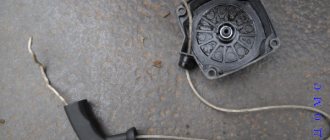Standard proportions
Problems often arise with the proportions of oil and fuel for reliable operation of a lawn mower. The reason for everything is completely different information in the sources. You may encounter a difference in the ratio data by a dozen units, or sometimes by half. Therefore, you involuntarily think about how much oil is needed for 1 liter of gasoline: 20 ml or all 40. But for this there is a technical passport for the product that you purchase in the store. There should be a description of the device, instructions for its operation and instructions on the rules for preparing the fuel mixture.
First of all, you need to take into account the information that the manufacturer recommends, since if the brush cutter fails, you can present your claims to him, and not to a third-party source. If there are no instructions in the passport, and even more so if there is no passport, then we recommend looking for another trimmer model from a more reliable seller.
For all other cases, when you have a model of a lawn mower in your hands and there is no way to find out its technical features, there are standard proportions of the most likely components of the fuel mixture for a two-stroke engine. Basically, these units use AI-92 gasoline and special synthetic oil, which contains a solvent for better mixing with fuel. This oil evaporates slowly and has the ability to burn completely in the cylinder without leaving soot.
The standard ratio of synthetic oil to gasoline is 1: 50. This means that 5 liters of gasoline require 100 ml of oil, and according to this, oil consumption per 1 liter of gasoline is 20 ml. Knowing the amount of oil required to dilute 1 liter of fuel, you can easily calculate any standards when preparing fuel for a trimmer. When using mineral oils, the standard ratio is most often 1:40. Therefore, 1 liter of fuel will require 25 ml of such oil, and 125 ml for a 5-liter canister.
When operating a lawn mower, it will not be difficult for a person who has little experience in operating such equipment to determine and adjust the actual amount of oil required for a particular model. You just need to pay attention to the exhaust gases (their color, toxic odor), stability of cycles, engine heating and developed power. More details about what consequences can be expected from incorrect mixing proportions of gasoline and oil are covered in another section of the article. There are variants of brush cutters that run on AI-95 gasoline. This should also be taken into account.
If the manufacturer recommends fuel with such an octane number, then you need to follow the requirements so as not to thereby reduce the operating life of the equipment.
Why mix trimmer oil with gasoline?
The two-stroke engine has a simple and, at the same time, extremely efficient design:
- the piston makes a power stroke every second stroke;
- the cylinder is lubricated with oil dissolved in gasoline;
- removal of combustion products occurs due to compression, without a special mechanism.
All this led to the creation of a family of small engines that were successfully adapted in household and professional equipment:
- trimmers;
- chainsaws;
- motorcycles;
- various walk-behind tractors.
Due to the design features, it was possible to achieve the desired fuel consumption only on small engines with a power in the range of 15 - 20 hp. This figure looks especially good in the range of 1 - 5 hp. Here, the low weight and dimensions of the engine fully correspond to gasoline consumption.
As the dimensions increase, the area of the inlet and outlet channels increases. The process of removing gases and supplying fuel deteriorates sharply. In this regard, it was necessary to switch to a more efficient combustion system for the gasoline mixture, which would include forced engine maintenance systems. Four-stroke models have thus seized the palm among high-power power units. Combining them into multi-cylinder designs allowed the creation of special systems related to the formation of the composition of the fuel mixture, lubrication, and other things, which had a beneficial effect on gasoline consumption.
Lubrication of the rubbing elements of the piston and cylinder of a two-stroke engine occurs with oil contained in a certain proportion in the composition of the fuel. Gasoline burns, and oil settles on the surface of the cylinder, reducing friction of the rubbing parts. Lack of lubrication leads to damage to the cylinder, even jamming. In case of excess, under the influence of high temperatures, a thermally modified product is deposited in the annular grooves. Compression drops, and so does power.
How to mix oil and gasoline
Motor oils are used to add trimmer gasoline to gasoline. Mixing is carried out in a certain proportion. Manufacturers have different volume ratios: from 1 to 50 to 1 to 20. There is a reference to this in the technical specifications. You should be careful with small proportions of oils. A slight inaccuracy leads to oil starvation of the engine and reduces its service life.
There are products that indicate a proportion of 1 to 20-40. It is better to refuse to use such a lubricant. A wide range of mixtures indicates low quality of the product. With constant use of such varieties, the occurrence of piston rings is practically guaranteed.
Motor oils, type M-8, are added in proportions of 1-20. Their use in high-speed engines is undesirable. The cycle between injections of the mixture is so short that it will cause an excess of lubricant in the cylinder. Trimmers have low speeds, so they can use low-grade lubricant. Due to the initially low resource, you don’t have to worry about coked rings. First, the equipment will be completely worn out.
It is important not to use the recommended oil or from other manufacturers. The main thing is to dilute gasoline with trimmer oil in accordance with the proportions in accordance with the characteristics of the product. It is illegal for service workshops to refuse a warranty solely on the basis of using a lubricant of a different brand, but with acceptable parameters.
READ How to Install Line on the Reel of an Electric Trimmer
Which oil to choose for refilling the trimmer or types of lubricants
Trimmers and lawn mowers are powered by two-stroke engines, which have a simplified design. It is rare, but there are models of trimmers with 4-stroke engines that run on pure gasoline. Two-stroke power units do not have a compartment for filling engine oil (oil sump), which reduces the weight of the tool and reduces their cost. If the rotating parts of the motor are not lubricated, they will eventually fail quickly. To prevent this, the trimmer is not refueled with pure gasoline, but with a mixture of oil. What oil should be diluted with gasoline for a trimmer?
First, let’s remember or find out what types of oils are produced according to their chemical composition:
- Mineral fluids are intended for low-power, air-cooled equipment. This is the cheapest type of lubricant for motors.
- Semi-synthetic substances - they are used for equipment that is air and water cooled
- Synthetic - suitable for all types of engines with different types of cooling. They do not require frequent replacement, and this type of lubricant is several times more expensive than mineral and semi-synthetic
From the above it follows that oil with any composition is suitable for the trimmer - mineral water, synthetic and semi-synthetic. Oils with different chemical compositions vary in price, so when purchasing, you need to rely on the recommendations of the tool manufacturer. The instructions provide recommendations on what types of oils are best to use. If this is the TS-W3 standard, then it is not so important what composition the substance should have. In this case, you can dilute mineral water, semi-synthetic and synthetic with gasoline.
This is interesting!
The main thing when choosing oil is not to fall for a fake, since today you can very often find different types of lubricating compounds for two-stroke engines, which consist mainly of low-quality petroleum products.
Choosing oil for lawn mowers - useful recommendations from professionals
If the instructions for the tool have been lost, and difficulties arise in choosing the appropriate oil, then it is recommended to choose the following two options:
- Semi-synthetic - cheaper than synthetics, but more expensive than mineral water. Suitable for equipment both Russian and foreign. They have low smoke parameters and take adequate care of the structural elements of the engine. Produced by distilling petroleum products and hydrocarbons
- Synthetic are expensive types of lubricants that are suitable for all types of equipment. If you use synthetics for your trimmer , then the engine of the tool will work like a clock
When choosing and purchasing oils for dilution with gasoline, you may encounter the fact that some letter designations are indicated on the cans. These designations are an API classification, which will be useful to know for those who want to fill a tool with a lubricant that suits the parameters. Let's consider all types of oils according to API classification for two-stroke engines:
- TA - intended for air-cooled devices with a volume of up to 50 cm3. Such equipment includes mopeds, lawn mowers, trimmers and brush cutters. The optimal solution for lawn mowers and trimmers
- TB - used to refuel the engines of such units as mopeds, chainsaws, scooters and motorcycles. The engine capacity of such equipment ranges from 50 to 200 cm3. This type of oil is also suitable for trimmers
- TC - intended for diluting with gasoline and pouring into motorcycles, snowmobiles and other types of land vehicles
- TD - used for refueling outboard motors, hydro scooters and boats
The API classification is an American standard used in Europe. However, when choosing, there are additional designations on cans of oils for two-stroke engines, for example, FA, FB, FC, FD and others. This is a classification of oils based on smoke emissions, which was developed by the Japanese JASO standard. If such designations are found on the selected oils for trimmers and chainsaws, then their meaning must be taken into account:
- FA - used in countries where legislation requires minimum smoke emissions into the atmosphere. Emit an invisible mist of smoke during operation
- FB - intended for use in countries where there are strict restrictions on smoke emissions into the atmosphere. Virtually no white smoke
- FC - the smoke released into the atmosphere is transparent and not noticeable to humans
- FD are smokeless types of oils for 2-stroke internal combustion engines that do not emit smoke, but also have improved chemical properties. They are usually used for mixing with gasoline and refueling boats, boats and yachts.
If the container with a lubricant contains the designation “self mix” and “pre mix”, then they mean self-mixing with gasoline (the first option, which does not require shaking), and the need for forced dissolution (the second option).
This is interesting! Oils for two-stroke engines are marked with the designation 2T.
Knowing the classification of oils according to their types, it will not be difficult to choose the best option for your brand of lawn mower. On the market you can find a variety of brands of oils for two-stroke engines, but it is better to pay special attention to the following companies:
- STIHL - they produce mineral and synthetic ones, but semi-synthetic ones of this brand are rare
- Shell Helix Ultra - recommended by experts
- Motul
- Oleo-Mac
- Echo
- Hammerflex
- Lukoil is a Russian oil that costs 3 times cheaper than foreign analogues, but at the same time has excellent quality indicators
Product prices are not indicated as their prices vary. There are many other brands, and if you still want to find the ideal trimmer lubricant for yourself, we recommend watching the test in the video clip below.
From the video we can conclude that it is not always useful to buy expensive oils, since they may be of unsatisfactory quality, as can be seen in a real example.
Conclusion about choosing oil! For a brush cutter, trimmer or lawn mower, it is better to choose synthetic or semi-synthetic oil marked TA or TB. In this case, take into account the manufacturer’s recommendations, since some manufacturers of high-quality equipment may recommend using only synthetic lubricants.
We understand the choice of gasoline for the AI-92 or AI-95 lawn mower
There are so many people, so many opinions, which applies not only to the choice of trimmer oil, but also gasoline. Likewise, in order not to make a mistake with the choice, it is recommended to use the brand of gasoline recommended by the manufacturer (indicated in the manual for the tool). However, not everything is so simple here, since at each gas station the brands of gasoline are only named the same, but have completely different compositions. You need to figure it out and come to a common conclusion about which brand is best to pour gasoline into a two-stroke engine for your trimmer.
Manufacturers recommend using A-92 gasoline for their equipment, and some models require the use of A-95 grade, which does not contain ethyl alcohol. It is not recommended to use gasoline grade AI-90 or lower, as they will lead to rapid wear of engine parts. When buying gasoline of one brand, you cannot be 100% sure that it corresponds to reality. The result is the following picture:
- The manufacturer recommends pouring fuel into the AI-92 trimmer
- The summer resident uses only gasoline of this brand, but buys it at gas stations where the price is lower or where he has to
- This negatively affects the internal parts of the engine, since at one gas station it is really high-quality AI-92 gasoline, and at the second - at best, if it is AI-80 and not AI-76
As a result, the motor suffers, and after a couple of years of using the new trimmer, it becomes necessary to overhaul it. To avoid having to analyze the quality of fuel or buy only expensive gasoline, it is recommended to refuel at only one gas station. At gas stations, gasoline is poured only into metal cans, not plastic.
There are manufacturers that produce special purified fuel for two-stroke engines. If you choose this option, then you will not need to choose the best gas station, brand of gasoline and control its shelf life.
Conclusion on choosing gasoline for a trimmer!
The trimmer must be filled with gasoline of the brand recommended by the manufacturer. If you fill the trimmer tank with A-95 gasoline, instead of A-92 (which is recommended by the manufacturer), the engine will heat up faster and become unstable. It is also better to choose A-92 Ecto gasoline, which has improved characteristics in terms of environmental friendliness.
How to dilute gasoline with trimmer oil?
The trimmer specifications contain links to recommended fuels and lubricants. At the same time, the octane number of the gasoline brand is indicated specifically, but for oils there is a lengthy explanation about the need to use a product from a certain manufacturer. To be sure, it is indicated that only if these recommendations are followed, the company extends the warranty. What is this: a marketing ploy or oils from other manufacturers do not meet the requirements? The answer is in this article.
If everything is in order with the electrical equipment, then we check the carburetor.
Vacuum carburetors are installed on trimmers. When disassembling, cleaning or washing it, you need to be extremely careful - under no circumstances disassemble the lower part of the carburetor, where the primer is located. The air filter (it is visible if you remove the protective casing from the carburetor) must be washed with detergents. Best for washing dishes. After drying, put it back. We wash the carburetor with clean gasoline and blow through all the holes with a pump. We also wash the fuel line filter, then dry and assemble everything. Usually, after all the manipulations, the trimmer starts working.
A thin cable instead of a fishing line, is it worth installing it on a brush cutter?
This thought comes to the mind of almost everyone who has had to mow 10 acres overgrown with tall grass. At first glance, the idea seems good. The cable is stronger than the fishing line and does not wear out as much. However, not all so simple.
How and how much to refill
Refilling the trimmer's fuel tank is easy. To do this, you need to place the tank in such a way that the lid is on top. The amount of fuel depends on the trimmer model. This information is indicated in the instructions, and there is also a mark directly on the tank.
how to dilute gasoline (AI 92) for a gas scythe, trimmer
This may cause fuel to spill into the intake manifold and fuel filter, which may cause engine damage or a fuel fire.
When refueling the trimmer, you must follow safety precautions:
- try to pour the liquid so that it does not spill; you can use a watering can for this;
- If gasoline does spill, it must be wiped up immediately;
- the trimmer should be started after the fuel container has been removed to a safe and secure place, preferably at a distance of more than 10 meters;
- During a long break between operations, drain the remaining fuel.
READ How Much Lubricant Does a Trimmer Gearbox Need?
The correct proportion and adherence to mixing and filling technology will help extend the life of the trimmer. It is recommended to choose only a high-quality product from the corresponding brand.
Consequences of violation of the ratio
The service life of the brush cutter engine depends on how accurately you follow the manufacturer’s recommended proportions of the oil-gasoline mixture. The fact is that the fuel mixture enters the cylinders in the form of gasoline-oil mist. And the task of the oil composition is to lubricate the moving and rubbing parts and surfaces of various parts located in the cylinder. If it suddenly turns out that there is not enough oil, and somewhere there is not enough oil at all, the parts coming into dry contact will begin to damage each other. As a result, scuffs, scratches and chips are formed, which will certainly lead to complete or partial unusability of the engine (for example, it may jam).
In the opposite case, when too much oil enters the engine, it does not have time to burn completely, settling on the cylinder walls and turning over time into solid particles - coke, slag, and the like. As you might guess, this also leads to engine failure. The most important thing is that you should not allow even a single violation of the proportion towards a lack of oil. It’s better to add a little oil 10 times than not add enough oil just once. It often happens that this time is enough to break the engine.
Preparation of the fuel mixture: proportion of oil and gasoline for a chainsaw
The chainsaw engine is the “heart” of the tool, so it is very important to use a properly prepared fuel mixture.
The fuel mixture for a chainsaw is made from two components - oil and gasoline. Chainsaws are equipped with two-stroke engines, so oil is not added to the lubrication system (like a four-stroke engine), but directly to gasoline. In this case, it is very important to maintain the correct proportions of ingredients; of course, under no circumstances try to work on pure gasoline, because in this way you will very quickly “kill” the chain saw.
If we talk about what kind of gasoline to pour into a chainsaw, then it would be optimal to use fuel with an octane rating of A-95; in this case, saving on fuel can turn out to be disastrous. Often European manufacturers indicate that you can use A-90 or A-92 gasoline, but in post-Soviet countries the quality of gasoline is inferior to European, so in our realities it is better to use higher quality gasoline.
As for the actual proportion of the gasoline-oil mixture, everything is simple: you must follow the instructions for the tool. All manufacturers of chainsaws indicate the required ratio in the instruction manual or in the tool passport; in addition, the proportions for refueling a chainsaw may differ depending on the model of the chainsaw. As a rule, the proportion of oil and gasoline to a chainsaw from famous manufacturers is the ratio of 1:40 or 1:50, which means 1 part oil to, for example, 40 parts gasoline. Now the arithmetic is 1 liter of gasoline = 1000 ml of gasoline, divide by 40 and get 25 ml of oil. If you follow the same steps to a ratio of 1:50, you get 20 ml of oil per 1 liter
gasoline.
As for budget chainsaws made in China, the situation is a little different. The ratio of gasoline and oil for chainsaws made in China
is 1:25, that is, we divide 1000 ml of gasoline by 25, we get 40 ml of oil. The thing is that branded chainsaws are well-assembled and the distance between the pistons and cylinders in the engine is much smaller than that of Chinese chainsaws, so the required amount of oil differs by almost two times.
In order to measure the correct portion of oil, use a regular medical syringe of sufficient volume.
Another subtlety
– first fill a dry gasoline canister with gasoline and then oil. The procedure, on the contrary, is fraught with a low-quality fuel mixture, because the oil is denser and will stick to the bottom of the canister - what good mixing is that?
Be sure to prepare the fuel mixture in a canister and pour the prepared special fuel into the gas tank! Never cook or mix it directly in the chainsaw's fuel tank!
If you have figured out the question of how to dilute gasoline for a chainsaw, then you have also figured out the storage conditions and expiration dates of the fuel mixture
It's worth saying a few words.
It is best and easiest to prepare a gasoline-oil mixture for 1 liter of gasoline; it is recommended to do this immediately before working with the tool. Chainsaw fuel tanks have a volume of 0.3 to 1 liter. In domestic use, the entire volume of the prepared combustible mixture is rarely used in one session, so the remainder can be saved until the next work session. The fuel mixture must be stored in a special gasoline canister in a dry, dark place. It is optimal to expect that the shelf life of the finished mixture will be 7-10 days
. The fact is that the oil currently on the market is not synthetic, but organic, that is, natural. After 10 days, all lubricating properties are lost; gasoline simply “eats” the oil. Naturally, it is no longer possible to use such fuel; this can cause breakdown and failure of the chainsaw.
At the end of the work, you need to drain the fuel mixture, start the chainsaw, the tool will stall (so that the saw has a dry carburetor) and now you can leave it until the next operating session.
Unsuitable fuel mixture must be disposed of.
Which lawn mower should you choose?
In order to have a beautiful green lawn on your property, you need to constantly care for it, namely, trim the grass. Therefore, it is important to purchase a high-quality gasoline trimmer that will last a long time. The modern lawn mower market offers a huge range of products, so it is often difficult to make a choice in favor of one model or another, especially for beginners.
When choosing a unit, you should adhere to some rules:
- Among the wide variety of models, you should opt for units with high power, since the fast and efficient operation of the trimmer will depend on this indicator. The engine should start effortlessly and have a system that regulates emissions of harmful substances. A light-weight unit is suitable for home use;
- The size of the tank depends on the time of continuous operation of the machine. The more fuel is poured into the tank, the longer the lawn mower can work, but the weight of the tool in this case will be greater;
- If you want to purchase a trimmer whose noise level during operation will be low, it is better to opt for devices with a four-stroke engine. The cost of such devices is higher than with a two-stroke engine, but they are much simpler and more enjoyable to operate;
- If you plan to mow a large amount of weeds or make hay for livestock, it is advisable to choose professional trimmers that can withstand significant loads for a long time. If the work will be carried out solely to improve the landscape design, then attention should be paid to the cutting parts of the device;
- the presence of a large number of trees, bushes or stones on the site precludes the use of a trimmer with metal blades. In this case, it is better to prefer a model with a cutting line, which will prevent damage to trees and the tool itself;
- The ease of use of the unit also depends on its handle. To work in large areas and with a wide swing, you should opt for a T-shaped handle, and for processing difficult-to-pass thickets, it is advisable to purchase a trimmer with a D-shaped handle.
How many types of engine are there?
When choosing a trimmer based on the type of motor, you should consider some features. Electric powered units have significant limitations in terms of providing power to the motor. Diesel engines, like on walk-behind tractors, are not offered for trimmers, taking into account low speeds.
WATCH THE VIDEO
Consider the features of the gasoline engines used:
- Two-stroke cycle. Structurally it is simpler. When servicing, they are demanding on the quality of the working mixture - any deviations lead to a reduction in engine life.
- Four-stroke cycle. There is no need to maintain a precise ratio of gasoline and oil for a lawn mower - mixture formation occurs automatically, and the working fluids are in two different containers. The product turns out to be more expensive, but it is quieter and the exhaust gases are cleaner.
Regardless of the type of gasoline engine selected, the selection of oil and gasoline is carried out strictly in accordance with the recommendations of individual manufacturers.
- Google+
- LJ
- Blogger










